Attached files
| file | filename |
|---|---|
| 8-K - FORM 8-K - MERCER INTERNATIONAL INC. | o58801e8vk.htm |
| EX-99.1 - EX-99.1 - MERCER INTERNATIONAL INC. | o58801exv99w1.htm |
Exhibit 99.2
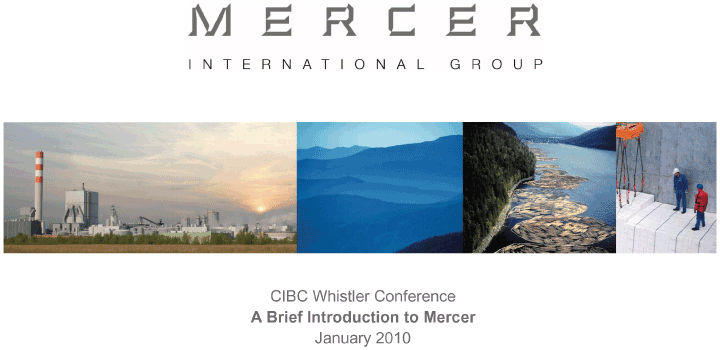
| CIBC Whistler Conference A Brief Introduction to Mercer January 2010 |
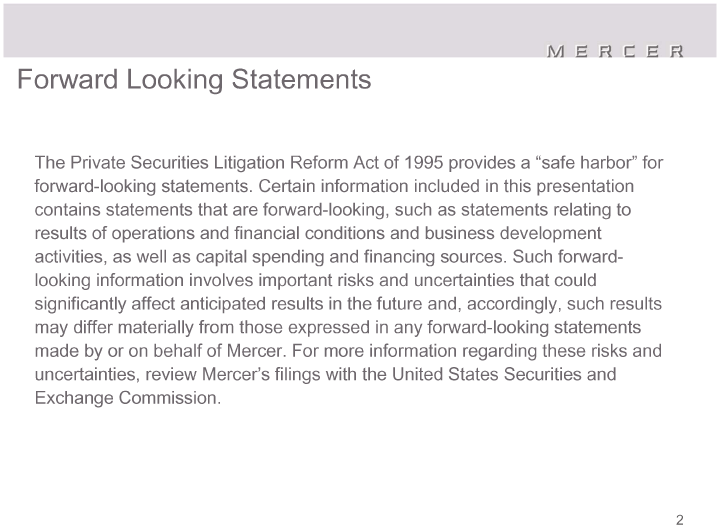
| for Forward Looking Statements The Private Securities Litigation Reform Act of 1995 provides a “safe harbor” forward-looking statements. Certain information included in this presentation contains statements that are forward-looking, such as statements relating to results of operations and financial conditions and business development activities, as well as capital spending and financing sources. Such forward- looking information involves important risks and uncertainties that could significantly affect anticipated results in the future and, accordingly, such results may differ materially from those expressed in any forward-looking statements made by or on behalf of Mercer. For more information regarding these risks and uncertainties, review Mercer’s filings with the United States Securities and Exchange Commission. 2 |
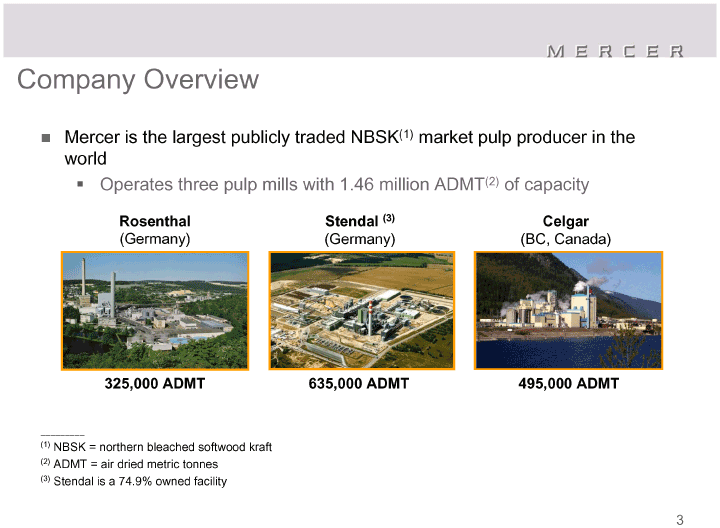
| Company Overview of capacity market pulp producer in the (2) (1) Operates three pulp mills with 1.46 million ADMT Mercer is the largest publicly traded NBSK world Rosenthal (3) Stendal Celgar ___NBSK = northern bleached softwood kraft ADMT = air dried metric tonnes Stendal is a 74.9% owned facility (1) (2) (3) 3 |
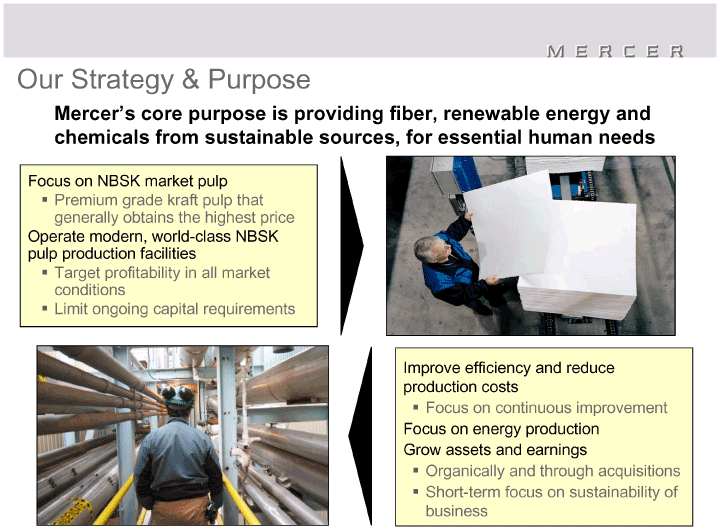
| Our Strategy & Purpose Mercer’s core purpose is providing fiber, renewable energy and chemicals from sustainable sources, for essential human needs Premium grade kraft pulp that generally obtains the highest price Target profitability in all market conditions Limit ongoing capital requirements Focus on NBSK market pulp Operate modern, world-class NBSK pulp production facilities 4 |
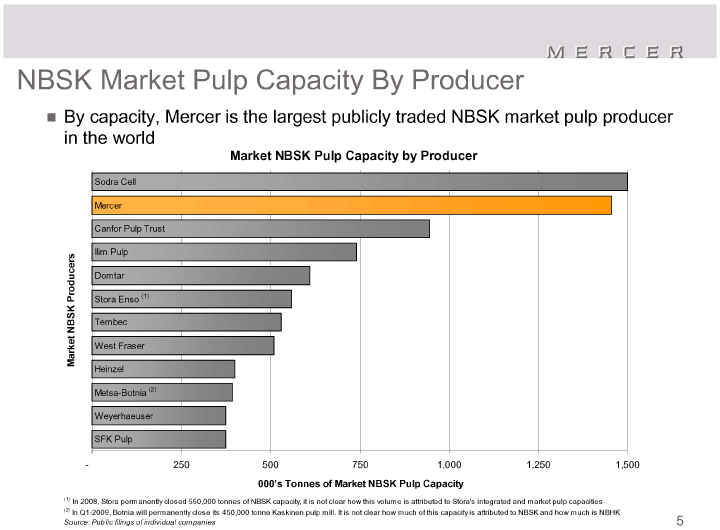
| Focus on continuous improvement Organically and through acquisitions Short-term focus on sustainability of business Improve efficiency and reduce production costs Focus on energy production Grow assets and earnings NBSK Market Pulp Capacity By Producer • producer pulp market NBSK traded publicly largest the is Mercer capacity, world the By in In 2008, Stora permanently closed 550,000 tonnes of NBSK capacity, it is not clear how this volume is attributed to Stora’s integrated and market pulp capacities In Q1-2009, Botnia will permanently close its 450,000 tonne Kaskinen pulp mill. It is not clear how much of this capacity is attributed to NBSK and how much is NBHK (1) (2) Source: Public filings of individual companies 5 |
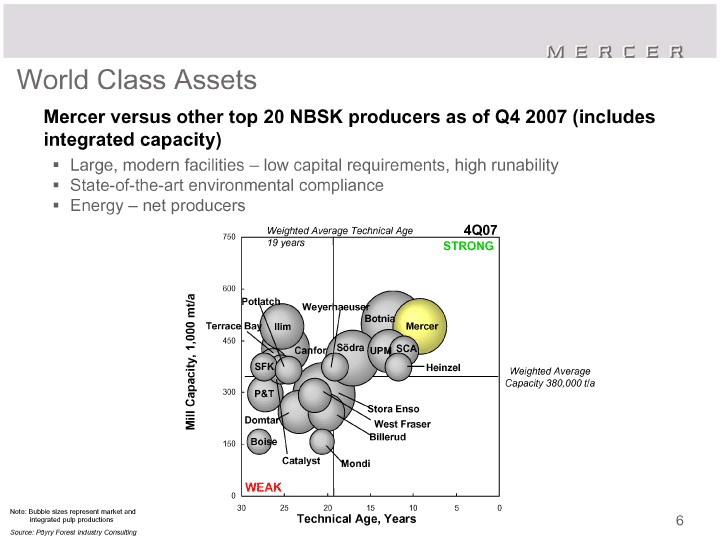
| World Class Assets Mercer versus other top 20 NBSK producers as of Q4 2007 (includes integrated capacity) • runability high requirements, capital compliance low – environmental facilities producers net modern –Large, State-of-the-art Energy • 1,000 mt/aCapacity, Mill Weighted Average Capacity 380,000 t/a Note: Bubble sizes represent market and integrated pulp productions Source: Pöyry Forest Industry Consulting 6 |
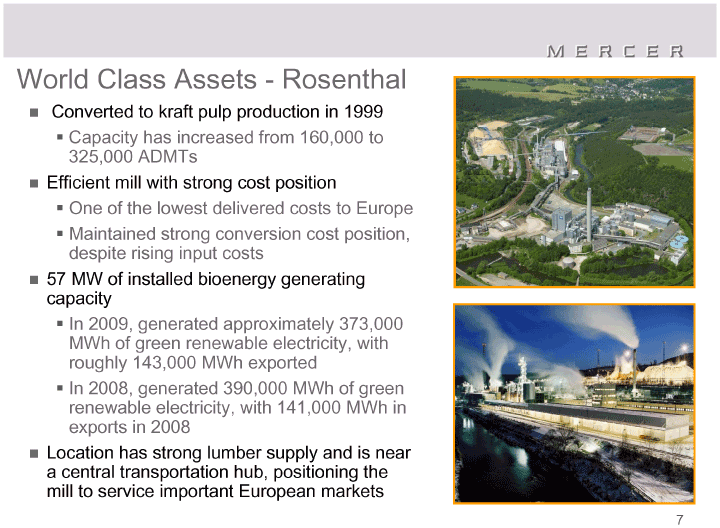
| Rosenthal World Class Assets — • 1999 to Europe position, to in 160,000 cost position costs generating from production cost delivered conversion costs pulp increased strong input bioenergy kraft with lowest strong to has ADMTs rising installed mill the of of Capacity 325,000 One Maintained despite MW Converted Efficient 57 • In 2009, generated approximately 373,000 MWh of green renewable electricity, with roughly 143,000 MWh exported In 2008, generated 390,000 MWh of green renewable electricity, with 141,000 MWh in exports in 2008 capacity • near the is and positioning markets supply European lumber hub, strong transportation important has service central to Location a mill |
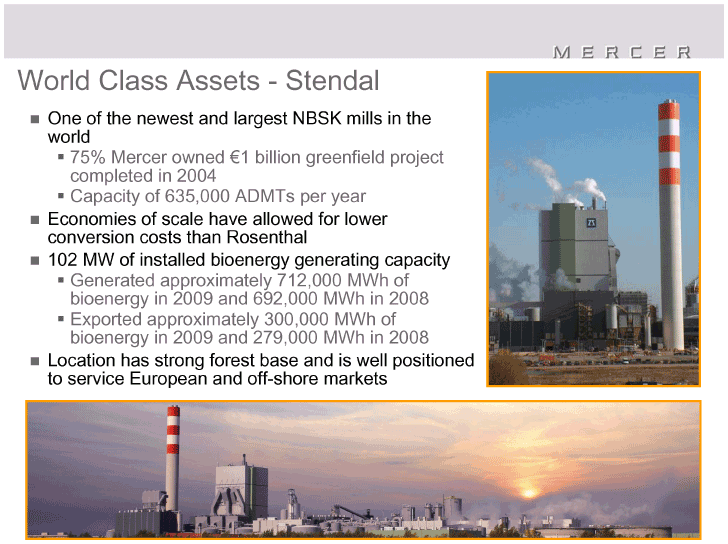
| Stendal World Class Assets — • the in mills NBSK largest and newest the of Oneworld project per year —1 billion greenfield ADMTs 75% Mercer ownedcompleted in 2004 Capacity of 635,000 • capacity of2008 lower MWhin for generating MWh allowed 712,000692,000 haveRosenthal bioenergy and than 2009 scale approximately in ofcosts installed of MW Generatedbioenergy Economiesconversion 102 • Exported approximately 300,000 MWh of bioenergy in 2009 and 279,000 MWh in 2008 • positioned well ismarkets and baseoff-shore forestand strongEuropean has Locationservice to |
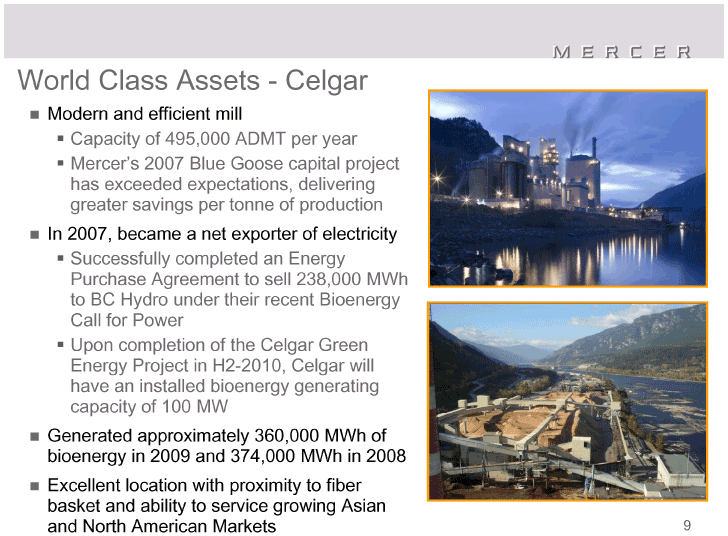
| Celgar World Class Assets — • project electricity MWh year Bioenergy per capital delivering production of Energy 238,000 of sell recent an ADMT Goose tonne exporter to their mill Blue expectations, per net efficient 495,000 a completed Agreement under of 2007 savings became Hydro Power and exceeded for BC • Capacity Mercer’s has greater 2007, Successfully Purchase to Call Modern In • Upon completion of the Celgar Green Energy Project in H2-2010, Celgar will have an installed bioenergy generating capacity of 100 MW • of 2008 MWh in fiber Asian 360,000 MWh to growing 374,000 proximity service Markets and with to approximately 2009 ability in location American Generated and North bioenergy Excellent basket and |
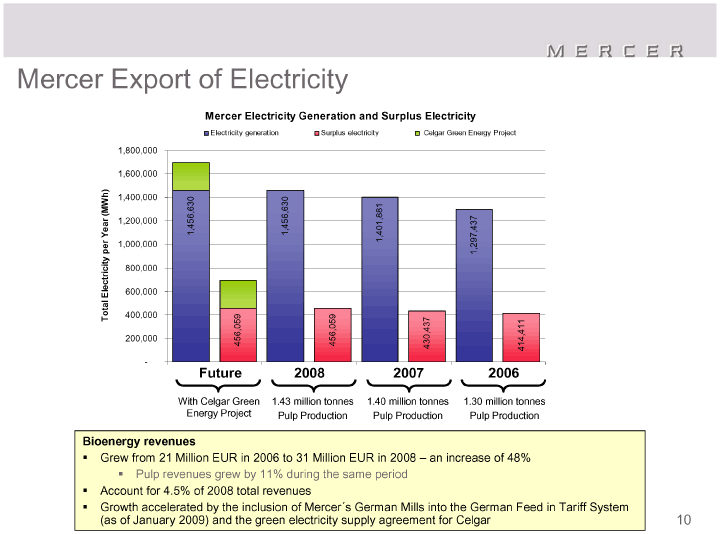
| Mercer Export of Electricity Mercer Electricity Generation and Surplus Electricity (MWh) per Year Electricity Total With Celgar Green Energy Project 1.43 million tonnes Pulp Production 1.40 million tonnes Pulp Production 1.30 million tonnes Pulp Production |
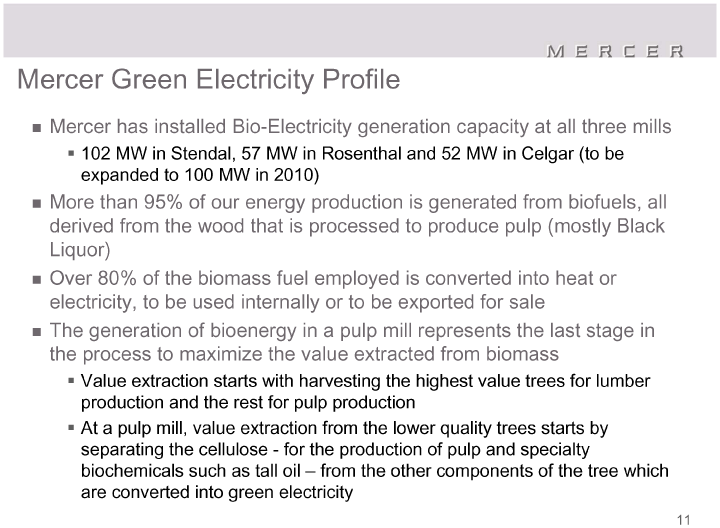
| Mercer Green Electricity Profile • mills all Black in three be or stage (to biofuels, all (mostly heat last at Celgar from into sale the in pulp biomass capacity MW for 52 generated produce converted represents from and is to is exported mill generation be extracted to pulp Rosenthal production processed employed or a in in value 2010) is fuel MW the in energy that Bio-Electricity 57 internally MW our wood biomass used bioenergy Stendal, 100 of of maximize installed to the the be to in 95% from of to has MW expanded than 80% generation process • 102 • Mercer More derived Liquor) Over electricity, The the • for the production of pulp and specialty from the other components of the tree which Value extraction starts with harvesting the highest value trees for lumber production and the rest for pulp production At a pulp mill, value extraction from the lower quality trees starts by separating the cellulose — such as tall oil –biochemicals are converted into green electricity 11 |
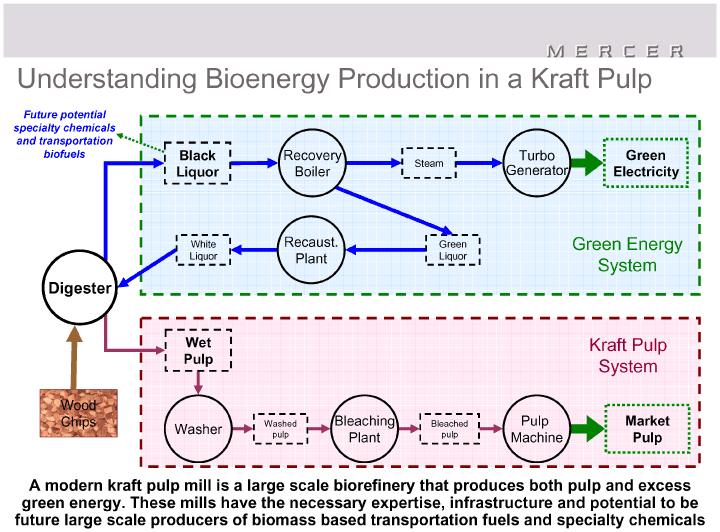
| that produces both pulp and excess 12 pulp mill is a large scale biorefinery A modern kraft green energy. These mills have the necessary expertise, infrastructure and potential to be future large scale producers of biomass based transportation fuels and specialty chemicals |
